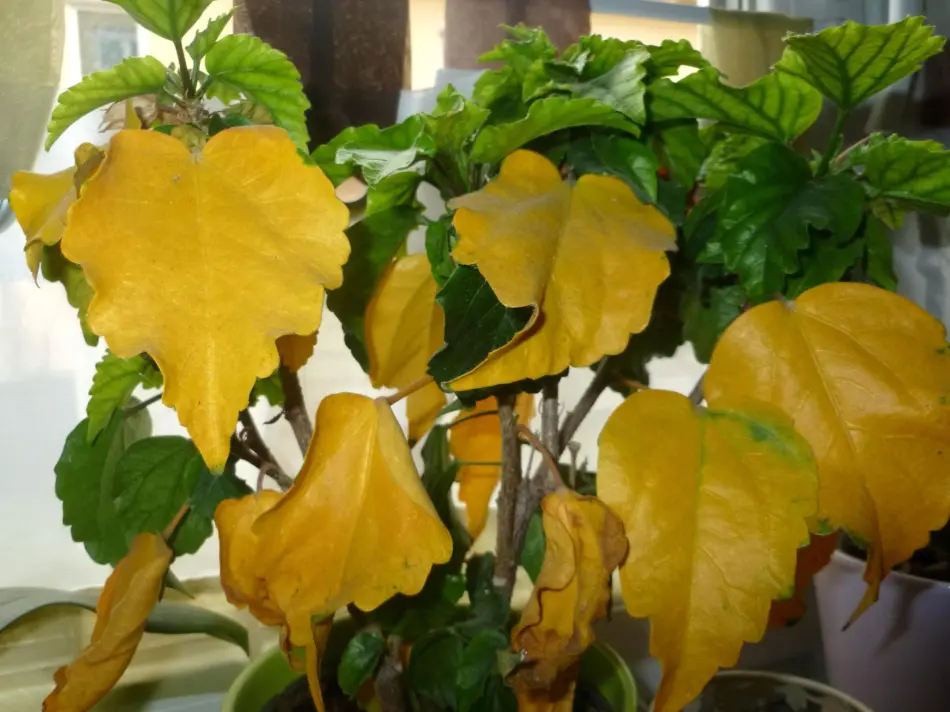Hibiscus, like other plants, needs nutrition. Yellow leaves and plant death may arise from a lack of nutrients. This, however, is not something to be concerned about. It’s completely normal, and it’s a regular occurrence. When Hibiscus is poor in nutrients and minerals, it turns yellow.
In this case, you’ll need to take several critical actions to help your hibiscus recover quickly. So, in this essay, I’ll discuss some of the most crucial precautions you can take to keep your hibiscus from becoming yellow. Without further ado, let’s get down to business.

Hibiscus Plant Turning Yellow
Hibiscus is a flower that needs a lot of attention and care. If you know what you’re doing, creating the ideal setting shouldn’t be tough. In order to make things as easy for you as possible, I have compiled a list of the most common causes.
These are some of the most common causes of yellowing in hibiscus. In addition, I’ve included some simple tips and tactics for protecting the plant.
Not Enough Nutrient
A hibiscus plant can become yellow for a variety of causes. One of the most important reasons is a shortage of essential nutrients for the plant. If not given appropriate nutrients on a regular basis, the plant begins to become yellow and finally dies.
Another possibility is that the soil is the problem. You do not need to be concerned, though, since there is a solution. You may help the plant grow by applying high-quality nutrients. There are many types and brands of fertilizers available. As a result, you may select the one that best suits your needs.
Needs More Water
Insufficient water availability can also cause hibiscus to turn yellow. Every day, plants require water and sunlight. They tend to perish fast if they are not given enough water. On the other hand, too much water might be a problem.
The best approach to safeguard the hibiscus is to give it a healthy quantity of water, since anything in excess might be harmful. It is sufficient to just water the plant every day in a balanced manner.
Temperature Extremes
The temperature has a significant effect on this as well. If you leave the plant in the sun without watering it for the entire day, it will quickly turn yellow. Hibiscus requires a lot of attention and protection, and if you aren’t careful, it won’t last long.
If the leaves are not properly cared for, they begin to fall off. This plant, on the other hand, cannot live in severely cold temperatures. Hibiscus will not survive if the temperature is too hot or too cool. In order for it to live and not turn yellow, you must maintain a consistent temperature.
What About Insects?
One of the most common causes of hibiscus becoming yellow is insect infestation. Pests can be small insects that eat the plant’s leaves and flowers, causing damage to the leaves and flowers. Spider mites, mealybugs, and other insects are examples of these pests.
In order to prevent serious damage to your hibiscus, you should be careful about insects like these. It not only causes yellow foliage, but it can also cause irreversible harm. As a result, cutting the damaged areas may be a viable option. You may also opt for it because proper sanitization might safeguard the plants.
Some Solutions
Hibiscus may be protected in a variety of ways. Spraying the plant with a solution of soap and water is one such approach. Aside from that, trim off the affected portions to prevent them from spreading or looking awful. Proper sunlight is also important since it destroys bacteria and pests and is necessary for plant growth.
Furthermore, watering the plant is a crucial feature that is really useful to the hibiscus. So, by following all of the necessary precautions, you can prevent hibiscus from becoming yellow and dying prematurely.
Hibiscus: Frequently Asked Questions
What is the best place to plant hibiscus?
Full sun is best for hardy hibiscus. Plants that are partially shaded will not grow or flower well. You may need to shade Hibiscus during the hottest part of the day if you live in a hot climate. Embrace the perennial flower beds with hibiscus along the border or at the back.
Are hibiscus plants perennial?
Are they perennial? Hibiscus plants will dormancy every year in the appropriate growing zone if they’re cold and hardy. Tropical varieties grow as annuals or houseplants and will remain evergreen in mild climates.
Should hibiscus be planted under shade or in the sun?
The best place to grow hibiscus is in direct sunlight. Humid, but well-drained soil is ideal for tropical hibiscus. A perennial hibiscus thrives best when the soil remains moist and never completely dries out. Tropical hibiscus is more tolerant of water than this type.
How easy is it to grow hibiscus?
As long as they have good drainage and a spot in full sunlight, hardy hibiscus plants are not hard to grow. Maintaining an even moisture level in the soil is the key to success.